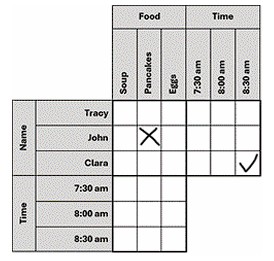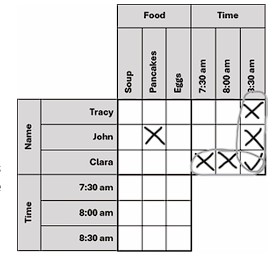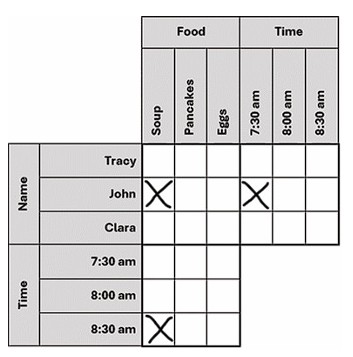How to Solve Logic Grid Puzzles
Logic grid puzzles are puzzles that involve using a grid to make deductions.
Each puzzle includes:
Introduction: You are presented with a puzzle to solve.
Clues: You are given all the information you need to solve the puzzle.
Logic Grid: You record the information from the clues in a grid, which helps you make further deductions.
Answer Table: You write down the solution to the puzzle on a table.
The logic grid is organized so that each item in one category matches with one item in another category. No item in one category can match two or more items in other categories. This means that all items in the different categories intersect with each other once, so you can figure out which items are matched.
Straightforward clues
These clues indicate that one item is or is not matched.
Three friends each have a particular breakfast they like to eat at a specific time every morning. Figure out what they eat for breakfast and at what time.
Clue: John never eats pancakes.
This is a straightforward statement that indicates John doesn’t eat pancakes.
False marker (X) in the John/Pancakes box.
Clue: Clara has her breakfast at 8:30 am each morning.
This directly tells us that Clara has her breakfast at 8:30 am.
True marker (✓) in the Clara/8:30 am box.

Whenever we put a ✓ in the logic grid, we can deduce that the true marker matches those two items, therefore the relationships to the rest of the items within the section are false.
Which means for the Clara/Time section:
Clara doesn’t have breakfast at 7:30 am or 8:00 am.
Tracy and John cannot have their breakfast at 8:30 am.
This deduction logic is a simple rule that will be helpful to you in every single puzzle. This deduction logic works because only one item can match with one other time within each category.

Quantitative relationship clues
This means that one item is either more or less than another item.
Clue: The person who has soup for breakfast eats it earlier than John.
This means that the soup eater’s breakfast time cannot be the latest time, which is 8:30 am, because there is someone who eats breakfast AFTER the soup eater.
(X) in the 8:30 am/Soup box.
This clue also means that John cannot have the earliest breakfast time, that is 7:30 am. Because the soup eater, and potentially another person, has breakfast EARLIER than him.
(X) in the John/7:30 am box.
Finally, this clue indicates that the soup eater has breakfast at a different time than John. This means that John cannot be the one who has soup for breakfast.
(X) in the John/Soup box.
